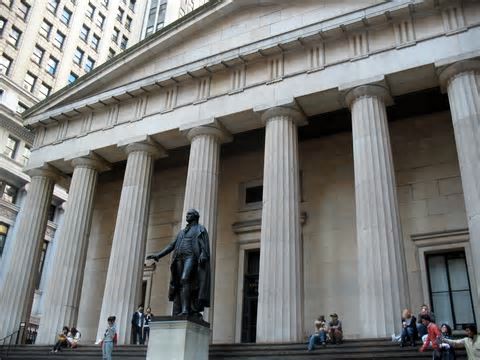Federal Hall
Introduction
Text-to-speech Audio
Images
Federal Hall

Backstory and Context
Text-to-speech Audio
The present day Federal Hall stands in the same location as the original City Hall that existed during colonial times. It was in that building where printer and journalist John Peter Zenger was tried for libel in 1733, after publishing views that criticized the royal governor. However, when Zenger's lawyer argued that the truth is a defense against libel, the jury decided that Zenger was, in fact, not guilty. This event would further help the people's case for liberty and freedom.
In 1765, the Stamp Act Congress took place in the City Hall. It was here where the delegates from the colonies protested their dissatisfaction with "taxation without representation." During this meeting, the Congress drafted the Declaration of Rights and Grievances. The document consisted of 13 points of the colonists' protests, the first united action by the colonies.
After the Revolutionary War, the nation searched for a location to establish a capital. New York City decided to hire architect Pierre L'Enfant to help remodel the old City Hall, and offered it to the national government. On April 30, 1789, at this location, George Washington took his first oath of office and was inaugurated as the first president of the United States. Federal Hall became home to the first Congress, Supreme Court, and Executive Branch offices. It was also where the Bill of Rights would be drafted, and eventually ratified.
In 1812, the building was demolished when the capital was moved south to Washington, D.C. The remains were sold for scrap, for around $425. A new building was built in its place using a Greek-revival style. This is the building that we currently see today. From 1842-1862, it served as the U.S. custom house for the Port of New York. Then, from 1862-1920, it served as the New-York sub-Treasury, storing up to 80% of the nation's wealth until the Federal Reserve was built in 1914.
In 1939 the Secretary of the Interior declared that the building was a National Historic Shrine, and in 1955 Congress renamed the building to Federal Hall, in honor of the previous building.
Cite This Entry
Harris, Jeremy et. al. "Federal Hall." Clio: Your Guide to History. November 15, 2020. Accessed April 5, 2025. https://theclio.com/tour/1872/13/reverse
Sources
"The Trial of John Peter Zenger." National Parks Service. Accessed March 19, 2017. http://home.nps.gov/feha/learn/historyculture/the-trial-of-john-peter-zenger.htm.
"The Stamp Act, 1765." The Gilder Lehrman Institute of American History. December 17, 2012. Accessed March 19, 2017. https://www.gilderlehrman.org/history-by-era/road-revolution/resources/stamp-act-1765.
Jessiekratz. "Protecting Copyright and the 'Encouragement of Learning'" National Archives Pieces of History. May 29, 2015. https://prologue.blogs.archives.gov/2015/05/29/protecting-elvis-and-the-encouragement-of-learning/
Parliament, British Parliament, Colonists, and American Colonists. "Magna Carta: Muse and MentorNo Taxation Without Representation." No Taxation Without Representation - Magna Carta: Muse and Mentor | Exhibitions - Library of Congress. November 06, 2014. Accessed March 19, 2017. http://www.loc.gov/exhibits/magna-carta-muse-and-mentor/no-taxation-without-representation.html.
Productions, Mixit. "Federal Hall National Memorial." Federal Hall Collections - NPS. Accessed March 19, 2017. http://mhsarchive.org/federal-hall.aspx?dir=feha.
"Federal Hall National Memorial." NYC-ARTS. July 01, 2011. Accessed March 19, 2017. http://www.nyc-arts.org/organizations/93/federal-hall-national-memorial.

